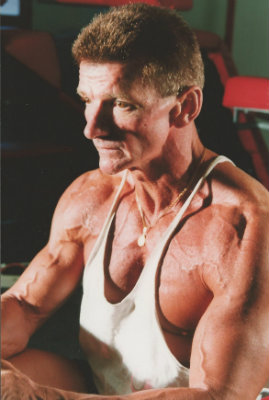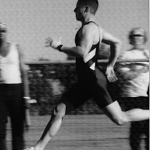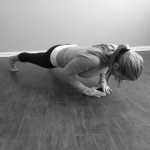Note: To put this article in context, read Should You Build Your Slow Fibers?, How to Build Your Slow Fibers, Part I, and How to Build Your Slow Fibers, Part II.
Adding a triceps ST hypertrophy protocol to your pressing regimen is not too much of a burden. Not too complex, not too draining. Ditto for pumping up your forearms. Attempting to combine FT and ST training for all major muscle groups is an altogether different ball game. Before you jump in head first, here is what you need to consider.
Slow Twitch Hypertrophy vs. Fast Twitch Hypertrophy
One of the flaws of the “everything works” and “change is good” bodybuilding mentality is a lack of traction. Say, you have built up your squats and quads with a classic FT protocol like 5×5. Lured by Prof. Selouyanov’s promise of adding 25% to your squat in six to eight weeks, you drop heavy squats and start burning your thighs out with light weights. Now even if you realize such gains, your hard-earned fast fibers will shrink. You have robbed Peter to pay Paul. And when you go back to heavy fives, you will repeat the process, only now it is Paul who will be robbed to pay Peter. So either keep training your slow fibers for the rest of your training life — or do not do it at all.
If you do decide to take on hypertrophy of both FT and ST — good luck! — you will need to train both fiber types concurrently, which is very demanding on your endocrine system, your time, and your programming skills. Or use block periodization that allows you to build one while maintaining the other and then reverse. Easier on the schedule and the glands; just as hard on the brain when it comes to planning.

Block Periodization for Slow Twitch Hypertrophy
Here is one template to consider. Alternate blocks of:
- FT hypertrophy and ST maintenance
- ST hypertrophy and FT maintenance
“Maintenance” means doing as little work as necessary not to go backward. Maintenance loads are individual, but 2-3 sets to failure once a week is a good starting point for your slow fibers. Based on Prof. Selouyanov’s research, even for maintenance ST fibers demand hard sets. Your fast fibers’ size, on the other hand, can be easily maintained without pushing to RM. Once a week remains the standard frequency; something along the lines of 2-3 easy sets of 5 with around 10RM should do the trick.
Start with four-week blocks. After several months, experiment with two-week blocks and see which option works better for you. I must stress that block periodization is an advanced planning tool. Do not use it until you are strong at least by gym standards: say multiple tactical pull-ups for a lady or half bodyweight strict one-arm military press for a gent. Otherwise, as I wrote before introducing another block periodization plan in Return of the Kettlebell, “burn before reading.”
Do neural training every week at low volume and varying intensity. If you need to peak your strength for an event, follow up several building blocks with a four-week peaking cycle in which you focus on heavy neural training while doing a minimal amount of maintenance work for both types of fibers.
Onto the weekly schedule. Train each muscle group two to three times a week. During the FT block there will be one heavy FT day and one light FT day plus a light ST session either on the same day as the light FT session or on a separate day.
Figure out the rest on your own. A tripwire: if you need any more information than that to plan out your FT+ST training, you should not be doing it.

Simpler Slow Twitch Hypertrophy
Although ongoing FT+ST hypertrophy training can and has been done, I am convinced that training the entire body in this manner it is too much commitment for everyone but professional bodybuilders. Most athletes should select one of the following simpler strategies:
- Only FT hypertrophy
- Only ST hypertrophy
- Only FT hypertrophy for some muscle groups and only ST hypertrophy for others
- Any of the above, plus both FT and ST hypertrophy for a select muscle group or two
When choosing between the FT and the ST, in one muscle group or in all of them, ask yourself the following questions:
“Psychologically, do I thrive on heavy fives or do I dig the ‘burn’?”
Some folks live for the heavy metal and an effort narrowly focused in time. When I suggested ST hypertrophy to Master SFG Brett Jones, he politely declined. As expected. Rob Lawrence once joked that when Brett and I had gotten together to train we did triples for “cardio.”
Others’ hearts do not flutter at the thought about barbells bending under many wheels; they prefer the slow torture of reps. If you choose the mode that does not suit your personality, the odds of you sticking to it for years and decades are slim.
“How important to me is endurance?”
If you can go either way, heavy or burn, and your sport demands endurance — any kind of endurance — make the ST choice. Remember, slow fibers come pre-equipped with mitochondria, which means you get both strength and conditioning.
“Do I have injuries preventing me from lifting heavy?”
If you do, ST training is the obvious choice. If your medical condition allows you to safely do a low volume of heavy lifts, by all means do them at least once a week for a few comfortable singles, doubles, triples. Otherwise, no matter how big your muscles get, your nervous system and connective tissues will not allow you to express their strength. ST hypertrophy plus ultra-low-volume, low-rep practice of the competitive lifts is a solid training strategy for an injured powerlifter or weightlifter.
If your doc does not allow heavy lifting at all, he might okay kettlebell swings plus ST goblet squats. Swings enable one to generate and withstand high forces even with a light weight. In the goblet squat, once you hit failure, descend rock bottom, wedge your elbows between your knees, and pry. Then park the bell and sit back on the deck. A powerful method for hard living types with high mileage.
Slow Twitch Hypertrophy in Summary
To summarize the slow fiber hypertrophy articles’ series, new Russian research presents fascinating training opportunities for a variety of athletes and non-athletes. It also adds even more choices to an already overwhelming menu the XXI century offers. Keeping it Simple & Sinister is always an option.





I have to apologize if I am missing something. Is it one partial rep per set or multiple slow partial reps per set. For example, if I am doing squats to I go from just above parallel to jut below parallel once in a minute or 3 to 4 reps in that time?
Is it recommended for those just beginning (or beginning again; in my own case I’ve just finished a cycle of over training at the behest of a coach, and now I am trying to be more sensible) to strive for FT only first, before worrying about ST? Or is it ok, if one is somewhat experienced, to integrate some ST training? In my own case, I want some increased leg and arm stamina for recreational soccer playing and BJJ, but I do not want to sabotage my training more than I already have.
I’ve never known much about slow fibers or how to build them, but I want to work on being healthier in that way. It is interesting that a big problem with this is a lack of traction, I had never considered this before. Thank you for such a detailed article demonstrating how someone can build their slow fibers. I will be applying many of your tips soon!
Hi Pavel, huge fan of your work. Great article series. I know you’re primarily strength based but I am curious as your opinion of fast twitch hypertrophy. I know you say for strength stay way clear of failure. And for slow twitch working to failure is a must. How about Fast twitch fiber hypertrophy? I know above you recommended 2-3 easy sets of 5 with a 10RM to maintain. Can you build up your FT fibers with that level of intensity (leaving 5 reps in the tank) with just more sets? I’m asking for strictly bodybuilding purposes. Thanks so much for your input!
Is training the ST muscles a good way to prepare for the Snatch Test and other SFG cert tests?
Which method FT or ST would be best for bodybuilding?
ur the best pavel
Pavel you are the best.
Please give me some feedback. I’m training for strength but I also want to improve my marathon time.
I’m currently doing 2x a week (Monday and friday) of barbell over head press and deadlifts in 2 sets of 5 reps and I do light kettlebell press GTG style and one or two reps a day of one arm chin ups and pistol squat on Tuesday, Wednesday and Thursday and sometimes even on the week ends.
For the legs, I run super easy for 2- 3 ours on Wednesday to train ST for 2-3 hours.
Is it a good idea to incorporate ST training for the legs using goblet squats on Monday and Friday while resting in between sets from my OHP and deadlifts?
**Additional comment**
Or how do I go about option 4? FT only for shoulders and back with OHP and deadlifts and then ST and FT with my legs for running endurance?
I only run (long and easy once a week ) apart from some running form drills that I do GTG style and occasional speed work
Vickeree, goblet squats before presses would smoke the shoulders.
Pavel,
You wrote another super interesting article, again! I have enjoyed the ST training info immensely. You might not have seen it, but on your ST (Part 1) article, I mentioned that a former coworker friend of mine used very slow gripper closes to train to the point where he was/is able to close the #3. It didn’t have much to do with your article, besides the fact that he performed the closes very slowly.
After reading Part 3 of your ST training installments, I am considering doing an ST training experiment that consists of mid-range (not fully open, not fully closed) gripper squeezes, following the ST training protocols that you have set out, as closely as possible. I have a toddler, a wife, and a busy work schedule, so this type of training would be workable (long rests between efforts) with our current lifestyle. “Current” meaning – “since we had our toddler”…
If you are at all interested in the results of this experiment (I won’t be offended if you are not!), I could write it all up in an article and submit it to you with the results. It might be of interest to some guys who want to do some grip training that shouldn’t interfere with their other strength training.
To begin the experiment, I will first get a baseline on my 1RM gripper strength. Using several different sets (how far the handles are or are not pulled together before starting to squeeze them together), I’ll see how much my top end strength has gone down since last year (almost exactly a year since I was training grippers). I have closed a #2 here and there I think three times since last year. That wasn’t even my #2, since I sold that last year. Anyway, I know my gripper strength stays well into the #2 range with no training these days. I have friends with grippers that can loan me a few for the first workout, so I can get a pretty close reading of my max gripper strength.
But I’m very curious to see if my top end strength will improve with the ST training. Plus, there might be some forearm growth, since I never focus on forearm size.
This ST training protocol will be especially unique (to me) because I am used to counting total reps, in the form of singles for the most part. I won’t even be counting with the ST training. Only keeping track of time. I have an easy method of microloading the few grippers I still have available to me for training. Zip ties come in handy for that. Secure (from one to about six) them around the spring and the gripper gets progressively harder to close. Works like a hoseclamp around the spring, but it’s more microloadable. Plus, you can use the colorful zip ties and it’s amusing to toddlers, lol.
My guess is that my 1RM strength on grippers will increase only slightly over baseline. But I think my forearm size will go up noticeably. Maybe 1/2” – even though I plan on losing a bit of weight before the end of the 6-week experiment.
I turn 40 years old in late May. So maybe it’s time to start working on my muscle appearance for once, vs. always trying to get stronger.
Ben, I just saw your post on the previous ST blog. A great success story!
I would love to hear about the results of your experiment and publish your article.
Pavel, thanks for your interest! And for the inspiration to even try a very unconventional grip training method like this. Even if the results are very minimal, it was still fun. And it got me back to training grippers again – although not like I was used to in my grip heyday, lol.
Well, it’s been 4 weeks on the experiment so far. I didn’t get to start it exactly when I wanted because of a slipped disk in my neck on March 15th. That knocked me out of commission for general training for a solid week. But I still managed to do the gripper training part because it didn’t affect my neck after getting on prednisone and painkillers.
I began the experiment on the 13th of March by testing my baseline max on some (what I consider) relevant grip events/feats/performances. Since I haven’t trained any of these particular grip events that I tested (in about a year), any increases over my baseline max will be due to the gripper program. Because nothing else about my training has changed. In fact, I haven’t even been doing my light kettlebell and bodyweight training at the same level as before the slipped disk. I’m about 90% recovered at this point. But by choice, I have been doing a very abbreviated schedule of about 10-25% of the amount of work I was doing before the injury.
I am looking forward to testing in about 2 weeks to see what the 6 weeks of training has done. My hands feel stronger than 4 weeks ago. That’s for sure. This might be a way to “trick” the body into quickly “recharging” the strength that was lost from disuse over time. I doubt any grip performances of mine are going to be higher than when I was training the grip events specifically. That part doesn’t matter though. It’s seeing any improvements at all with such a little amount of actual training. Plus, little time spent training is almost secondary to the fact that the grip training has not been what most would consider anything that would have carryover to the grip events that I tested about 4 weeks ago as a baseline.
I will list the baseline maxes and the after 6 week results on or around April 28th. That will be the 6 week mark of training on this method.
I’m not trying to be an info tease, but wanted to let anyone that was interested in the results know that I’m still quietly working on this.
Pavel, I’m curious if one should be wary about shortening the hip flexors and hip extensors if they choose to pursue ST style SQs exclusively?
Will any of these concepts be covered at Plan Strong?
Travis, no, Plan Strong is narrowly focused on one particular classic methodology.
And a wonderful methodology it is!
Hello
I found this series very interesting, thanks for posting. Could one do ballistics on the same day as ST work, or do you think that would be too much? I suppose I could always experiment…
Thanks again for the great series
Tim, it depends on the muscle groups. For the upper body—yes; for the lower body it will be way too much.
Swings or snatches followed by triceps ST work is fine.
How would you program swings and ST goblet squats?
Jonathan, SQs twice a week according to Selouyanov’s protocol; swings 3-4 times a week on other days.